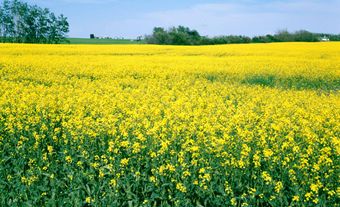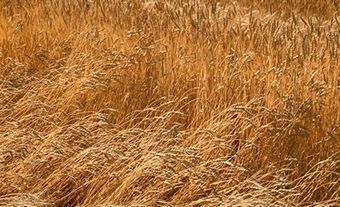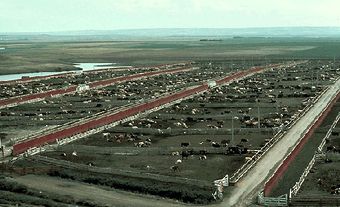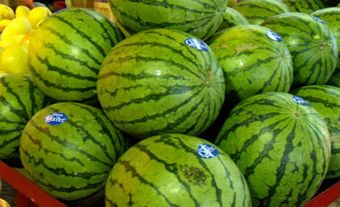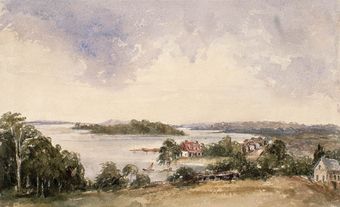Canadian agriculture has experienced a markedly distinct evolution in each region of the country. A varied climate and geography have been largely responsible, but, in addition, each region was settled at a different period in Canada's economic and political development. The principal unifying factor has been the role of government: from the colonial era to present, agriculture has been largely state-directed and subordinate to other interests.
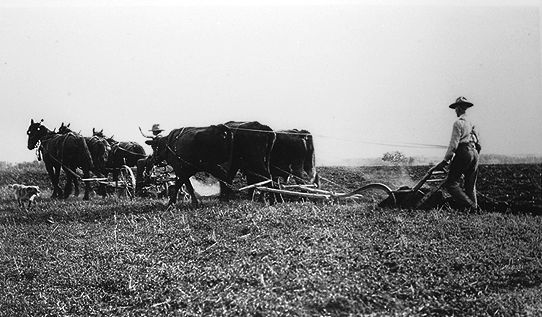
Indigenous Practices
Prior to the arrival of Europeans, Indigenous peoples of the lower Great Lakes and St Lawrence regions planted two types of maize, squash and beans, and practised seed selection. (See also Eastern Woodlands Indigenous Peoples in Canada.) Long before the appearance of French traders, agricultural First Nations traded maize for skins and meat obtained by woodland hunters. After the advent of the fur trade, Algonquian middlemen traded maize with more distant bands for prime northern pelts, and traded furs, in turn, with the French. First Nations agriculture was important in provisioning the fur trade until the late 18th century.
Maritimes
18th century – mid-19th century
Maritime agriculture dates from the establishment of Port-Royal by the French in 1605. Acadian settlers diked the saltwater marshes in the Annapolis basin and used them for growing wheat, flax, vegetables and pasturage. After the signing of the Treaty of Utrecht (1713), France withdrew to Plaisance, Newfoundland; Île Royale (Cape Breton Island); and Île St-Jean (PEI). They intended Île St-Jean to serve as a source of grain and livestock for their naval and fishing base on Cape Breton. Few Acadians moved from their homeland to Île St-Jean before the 1750s. By mid-century the predominantly fishing population in Île Royale was cultivating small clearings with wheat and vegetables and possessed a variety of livestock.
After acquiring Acadia in 1713, Britain promoted Maritime agriculture in pursuit of objectives of defence and mercantilism. Provisions were needed to support Nova Scotia's role as a strategic bulwark against the French. Britain also promoted agriculture to supply provisions for the West Indies trade, and hemp for its navy and merchant marine. Financial incentives were offered to Halifax settlers to clear and fence their land, but the lack of major markets kept the area in a state of self-sufficiency. The Acadians continued to supply produce to the French on Ile Royale, an act which contributed to their expulsion by the British in 1755. Some Acadians were later asked, however, to instruct the British in marshland farming. The influx of Loyalist settlers in the 1780s increased demand for marshland produce. Since the American states provided stiff competition in flour and grains, the Fundy marshlands were largely turned to pasture and hay for cattle production. On PEI the British government attempted to promote agricultural settlement by granting 66 lots of 8,094 ha to private individuals.
Between 1783 and 1850 agriculture was dominant in PEI, but subordinate to the cod fishery and the trade with the West Indies in Nova Scotia, and secondary to the timber trade and shipbuilding in New Brunswick. With British and Loyalist immigration, the area of agricultural settlement in the Maritimes expanded from the marshlands to include the shores of rivers, especially the Saint John. Although the new areas were suited to cereal production, settlers tended to engage in mixed farming for cultural, agricultural and marketing reasons. Most full-time farmers concentrated on livestock raising, which required less manpower than did cereal growing. Before 1850 both Nova Scotia and New Brunswick remained net importers of foodstuffs from the United States. PEI alone achieved an agricultural surplus, exporting wheat to England as early as 1831.
Agricultural development in the early 19th century was limited by the skills post-Loyalist immigrants possessed. Most of these settlers were Highland Scots who were ill-prepared for clearing virgin forest, and the standard of agricultural practice was low. In 1818, John Young, a Halifax merchant using the name "Agricola," began agitating for improved farming methods. As a result, agricultural societies were formed with a government-sponsored central organization in Halifax. Young's efforts had virtually no impact, however, since merchants were not involved in local farming. Hence there was little economic incentive for farmers to produce a surplus for sale. Nonetheless, agricultural lands and output grew gradually, and by mid-century the farming community was a political force, demanding transportation improvements and agricultural protection.
Mid-19th century – Early 20th century
After 1850 Maritime agriculture was affected by two principal developments: the transition throughout the capitalist world from general to specialized agricultural production and, especially after 1896, the integration of the Maritime economy into the Canadian economy. The last two decades of the 19th century witnessed an increase in the production of factory cheese and creamery butter and a rapid increase in the export of apples, especially to Britain (see Fruit and Vegetable Industry).
After 1896 the boom associated with Prairie settlement opened the Canadian market to fruit (especially apples) and potatoes. By the 1920s, the British market for Nova Scotia apples was threatened by American, Australian and British Columbian competition, notwithstanding improvements introduced by Nova Scotia producers to increase efficiency. The Canadian market for potatoes was supplemented by markets in Cuba and the US. Although Cuba moved to self-sufficiency after 1928, PEI retained some of the market by providing seed stock.
Those sectors of Maritime agriculture dependent on local markets began to suffer in the 1920s. Difficulties in the forest industries contributed to the disappearance of markets, and the introduction of the internal combustion engine diminished the demand for horses and hay. Meat from other parts of Canada supplanted local production. In the 1930s the potato export market suffered as American and Cuban markets became less accessible. These factors, coupled with problems in the silver fox industry (see Fur Farming), were catastrophic for PEI; its agricultural income dropped from $9.8 million in 1927 to $2.3 million in 1932. Only the apple export market remained stable, a result of British preferential tariffs on apples from the empire. In response to various difficulties during the 1930s, many farmers turned to more diversified self-sufficient agriculture, a change reflected in increased dairy, poultry and egg production.
Newfoundland
In Newfoundland agriculture was never more than marginally viable. Nonetheless, fishermen practised subsistence agriculture along the creeks and harbours of the East Coast, and commercial farming developed on the Avalon Peninsula and on parts of Bonavista, and Notre Dame and Trinity bays. Newfoundland's agricultural history really began with the food shortages associated with the American Revolution, when 3,100 ha were prepared for agriculture in the St John's, Harbour Grace and Carbonear areas. In the early 19th century a number of factors combined to give an impetus to agriculture: the arrival of Irish immigrants with agricultural skills, the growth of St John's as a market for vegetables, a road-building program, and in 1813 an authorization allowing the governor to issue title to land for commercial use.
In the late 19th and early 20th centuries the government intensified its efforts to interest the people in agriculture. By 1900, 298 km2 were under cultivation and there were some 120,000 horses, cattle and sheep in the colony. Through the Newfoundland Agricultural Board (formed 1907) the government established agricultural societies (91 in 1913) which provided assistance in such things as land clearing and the acquisition of seed and farm implements. In the 1920s, the government imported purebred animals to improve the native stock. In the 1930s, in order to mitigate the hardship of the economic depression, the government responded to the urgings of the Land Development association, a private group, by providing free seed potatoes in an effort to promote "garden" cultivation. Upon joining Confederation in 1949, Newfoundland took advantage of federal government funding to establish agricultural measures such as a loan program, a land-clearing program, and the stimulation of egg and hog production.
Quebec
17th and 18th Centuries
In 1617, Louis Hébert began to raise cattle and to clear a small plot for cultivation. Small-scale clearing ensued as settlers planted cereal grains, peas and corn, but only six ha were under cultivation by 1625. Beginning in 1612 the French Crown granted fur monopolies to a succession of companies in exchange for commitments to establish settlers. The charter companies brought some settlers, who used oxen, asses and later horses to clear land, but agricultural self-sufficiency was realized only in the 1640s and marketing agricultural produce was always difficult during the French regime. In 1663, Louis XIV reasserted royal control and promoted settlement by families. Intendant Jean Talon reserved lots for agricultural experimentation and demonstration, introduced crops such as hops and hemp, raised several types of livestock and advised settlers on agricultural methods. By 1721 farmers in New France were producing 99,600 hectolitres (hL) of wheat and smaller amounts of other crops annually, and owned about 30,000 cattle, swine, sheep and horses (see Seigneurial System).
After 1763 and the arrival of British traders, new markets opened for Canadian farm produce within Britain's mercantile system. Francophone habitants predominated in the raising of crops, but they were joined by anglophone settlers. British subjects purchased some seigneuries, which they settled with Scottish, Irish and American immigrants. New Englanders also settled the Eastern Townships and other areas. Anglo-Canadians promoted some new techniques of wheat and potato culture via newspapers and in 1792 formed an agricultural society at Quebec.
While the focus of the government's promotional activity was in Upper Canada (Ontario) and the Maritimes, Lower Canada (Quebec) enjoyed a modest growth of wheat exports before 1800. Nevertheless, Lower Canadian wheat production lagged far behind that of Upper Canada in the first half of the 19th century. The failure of Lower Canadian agriculture has been blamed by some on the relative unsuitability of the region's climate and soils for growing wheat, the only crop with significant export potential; soil exhaustion; and the growth of the province's population at a faster rate than its agricultural production in this period. Because there was little surplus for reinvestment in capital stock, Lower Canada was slow to develop an inland road system, and transport costs remained relatively high.
Early 19th Century – Mid-20th Century
By the 1830s Lower Canada had ceased to be self-sufficient in wheat and flour, and increasingly began importing from Upper Canada. The mid-century gross agricultural production of Canada East (Québec) totalled $21 million — only about 60 per cent of Canada West's (Ontario's) production. Both modernizing and traditional farms contained more children than they could adequately support, and widespread poverty induced thousands of habitants to migrate to Québec's cities and New England (see Franco-Americans). As well, spurred by religious colonizers, settlement pushed north of Trois-Rivières, south of Lac Saint-Jean and south along the Chaudière River. However, little commercial agriculture was practised.
Later 19th-century Québec agriculture was marked by increases in cultivated area and productivity, and by a shift from wheat production to dairying and stock raising. From the 1860s government agents worked to educate farmers to the commercial possibilities of dairying, and agronomists such as Édouard Barnard organized an agricultural press and instituted government inspection of dairy products. Commercial dairies, cheese factories and butteries developed around the towns and railways, most notably in the Montreal plain and the Eastern Townships. By 1900, dairying was the leading agricultural sector in Québec. It was becoming mechanized in field and factory and increasingly male-oriented as processing shifted from the farm to factories. By the end of the century 3.6 million kg of Québec cheese were being produced, an 8-fold increase since 1851.
By the 1920s, however, agriculture accounted for only one-third of Québec's total economic output. The First World War had artificially stimulated production, and new mining, forestry and hydroelectric ventures opened up new markets; but they also contributed to and symbolized the shift from agricultural to industrial enterprises in the Québec economy. By the 1920s Québec soil was again becoming exhausted due to a lack of fertilizer which stemmed from a lack of credit. Farmers' political organizations, such as the Union catholique des cultivateurs (founded 1924), addressed the problem of lack of credit and other issues.
Like their counterparts elsewhere in Canada, Québec farmers suffered during the 1930s. In areas removed from urban markets there was a return to non-commercial agriculture, with a consequent increase in the number of farms. During the decade farm income decreased more drastically than did urban wages. The Second World War marked a return to widespread commercial agriculture, and postwar trends included a decrease in the number of farm units and in farm population, and an increase in the average size of farm holdings.
Ontario
Late 18th Century – Mid-19th Century
American independence in 1783 both created a potential security threat on British North America's southern border and cut off Britain's principal agricultural base in North America. The British channelled Loyalists into the lower Great Lakes region, where Governor Simcoe suggested settling soldiers along the waterfront for defence, with other settlers filling in the land behind. The authorities initially promoted hemp culture as an export staple to stimulate British manufacturing and contribute to defence. However, scarcity of labour in relation to land inhibited its production. Between 1783 and 1815 settlement filled in along the lake shores and the St Lawrence, where some cereal grains and vegetables were grown, chiefly for subsistence.
Agriculture in what is now Ontario was dominated from 1800-60 by wheat production. Wheat was the crop most easily grown and marketed and was an important source of cash for settlers. Apart from limited internal demand from such sources as British garrisons, canal construction crews and lumber camps, the principal markets were Britain and Lower Canada. Between 1817 and 1825 Upper Canadian farmers shipped an average of 57,800 hectolitres (hL) to Montreal.
Dependence on wheat culture was reflected in a boom-and-bust economy. The application of the Corn Law restrictions in 1820 effectively shut BNA wheat out of British markets, causing a disastrous drop in wheat prices and land values. With the fixing of preferential duties for BNA wheat in 1825, prices and export volumes rallied, but the market collapsed in 1834-35. Crop failures in the late 1830s resulted in near starvation in many newly settled areas.
Mid-19th Century – Early 20th Century
Despite the American tariff, similar failures in the United States created a temporary market for surplus Upper Canadian wheat. Meanwhile, transportation improvements facilitated shipments out of the region. As a result of these improvements, favourable climate conditions and growth in markets, wheat exports increased from 1 million hL in 1840 to 2.25 million in 1850.
After 1850, Ontario’s agriculture became increasingly diversified. Repeal of the Corn Laws in 1846 removed the preferential status of BNA wheat and therefore promoted price instability, but higher American prices after the discovery of California gold helped producers overcome trade barriers to livestock, wool, butter and coarse grains. Favourable trading conditions continued with the Reciprocity Treaty, 1854-66. Moreover, a price depression in 1857 and crop destruction by the midge in 1858 hastened the switch to livestock. In 1864 factory cheese making was introduced, and by 1900 Canadian cheddar cheese, largely from Ontario, had captured 60 per cent of the English market. Two farmers’ organizations — the Grange (after 1872) and the Patrons of Industry (after 1889) — reflected a developing producer consciousness among Ontario farmers.
Technological developments assisted both the grain and livestock sectors in the 19th century. Field tillage was improved by the introduction of copies of American cast-iron plows after 1815. To control weeds biennial summer fallow (i.e. unsown land) was generally practised between about 1830 and 1850, when crop rotation became prevalent. Government authorities also promoted the British technology of covered drains to reclaim extensive tracts of swampy or bottom land, averting the use of furrow and ditch drainage that impeded mechanization. The reaper diffused rapidly in the 1860s, permitting increased grain production. Widespread use of the cream separator by 1900 promoted butter production, while refrigeration was a catalyst to the beef and pork industry.
Early – Mid-20th Century
In the late 19th and early 20th centuries, urbanization expanded the demand for market gardening around cities and more specialized crops in different regions. These included orchard farming in Niagara Peninsula, Prince Edward and Elgin counties, and tobacco in Essex and Kent counties. Dairying developed on the fringes of cities and cash crop acreages declined in favour of feed grains and fodder, while beef producers were unable to meet the domestic demand. Throughout rural Ontario there were farm-initiated associations of stockbreeders, dairy farmers, grain growers, fruit growers, etc., as well as the government-initiated Farmers' Institutes and Women's Institutes. The associations reflected a faith in farm life in the face of rural depopulation and an industrializing society. Various farmer-initiated groups worked in the United Farmers of Ontario movement, which formed the provincial government in 1919 under E.C. Drury.
During the 1920s Ontario farmers experienced a taste of prosperity as prices increased on various agricultural commodities. One result of this prosperity was a decline in the drift to the cities. By 1931, however, Ontario farm receipts had decreased 50 per cent from 1926. Although Ontario escaped the drought conditions of the Prairies, farmers were unable to market much of their produce, and surplus meat, cheese, vegetables and apples were shipped west. The government responded to the crisis with regulation, with dairying being the most important example. The Ontario Marketing Board was formed in 1931 with a 5-year plan instituted in 1932. In return for government loans, producers improved their herds and modernized their barns. By the Second World War Ontario agriculture was diversified for an urban market, with both agricultural marketing boards and farmer-owned co-operatives playing important roles.
The Prairies
Early 19th Century – Early 20th Century
In western British North America, Scottish settlers practised river-lot agriculture at Red River Colony after their arrival in 1812. While the survey system was French Canadian, agricultural practices followed the Scottish pattern. Land adjacent to the river was cultivated in strips in the manner of the Scottish "infield," with pasturage reserved for the "outfield" behind. The Métis alternated agriculture with seasonal activities such as the Buffalo Hunt. The Red River Colony came to assume a role in provisioning the fur trade alongside Indigenous and company agriculture.
Confederation was the spur to the agricultural development of the Prairie West. In the mid-19th century central Canadian businessmen were seeking investment opportunities to complement central Canada's industrial development. The prospect of agricultural expansion in the western interior was very appealing. Canada proceeded to purchase the Hudson's Bay Company's Rupert’s Land (1870), repress Métis resistance (1869-70 and 1885), displace the Indigenous population, and survey the land for disposal to agricultural settlers (see Dominion Lands Policy). Wheat quickly established its economic importance. However, continuing low world prices, culminating in a worldwide depression in the early 1890s, halted development until 1900. Western Canada's dry climate and short growing season were the most serious stumbling blocks. Genetic experimentation, leading to the development of Marquis wheat in 1907, in combination with the Dominion government's promotion of summer-fallowing to conserve soil moisture and control weeds, helped remove the technical barriers to continued agricultural expansion.
Large-scale ranching on leased land began in what is now southern Alberta and Saskatchewan in the 1870s and 1880s. The area's dry climate was practically overcome by small-scale irrigation from the 1870s on and by the introduction of an irrigation policy in 1894. Western agriculture received the necessary economic stimulus from an overall decline in transportation costs (see Crow’s Nest Pass Agreement) and a relative rise in the price of wheat in the late 1890s.
Under Clifford Sifton’s immigration schemes, the Canadian government effectively completed the agricultural settlement of the Prairies. Mechanization of the wheat economy with steam, gas tractors, gang plows and threshing machines contributed to huge production surpluses. An unprecedented boom in wheat prices during the First World War promoted cultivation of new lands. Price depressions in 1913 and after the war precipitated many bankruptcies by overcapitalized farmers. Nevertheless, between 1901 and 1931 the amount of land under field crop on the Prairies jumped from 1.5 to 16.4 million ha.
Early 20th Century – Mid - 20th Century
The collapse of wheat prices after First World War had serious consequences for Prairie farmers. Many operators who had purchased implements and more land at high prices during the war defaulted and lost their farms. Throughout the 1920s and 1930s operators of farms on poorer soils consistently lost money, as did farmers in the dry belt of southwestern Saskatchewan and southeastern Alberta. Drought, grasshoppers and crop disease further worsened conditions for farmers in the 1930s; the government responded with the Prairie Farm Rehabilitation Administration. Technological advances such as the development of the combine harvester resulted in both more efficient agriculture and the forcing off the land of farmers lacking sufficient capital to purchase the new technology. The mechanization process in Prairie agriculture as a whole was essentially halted during the 1930s, to be dramatically resumed after the Second World War.
From the early settlement era western farmers depended on central Canadian business to provide their production inputs and to finance, purchase and transport their grain. In order to gain some control over the economic forces which controlled them, organizations were formed to advance their interests. Early agrarian movements in Manitoba and the Northwest Territories espoused the virtues of co-operation and criticized the Canadian government’s tariff policy, freight rates and federal disallowance of railway charters to the Canadian Pacific Railway's rivals. After forcing the government in 1899 to ensure better service from the railways, farmers formed Grain Growers’ Associations in the Territories in 1901-02 and in Manitoba in 1903. These organizations carried on educational work among farmers, promoted provincial ownership of inland elevators and, ultimately, campaigned for the co-operative marketing of grain. This latter objective was achieved in 1906 with the formation of the Grain Growers' Grain Company.
The Grain Growers' Grain Company is representative of the first phase of Prairie co-operative grain marketing. In the context of heightened farmer and worker consciousness after the First World War, it came under criticism for having become too business-oriented. A radical wing developed in the Prairie farm movement, led by H.W. Wood of the United Farmers of Alberta. In 1923-24 farmers organized compulsory pools ¾ a new form of co-operative marketing ¾ in the three Prairie provinces (e.g., see Saskatchewan Wheat Pool). Pools were successful throughout the 1920s, but collapsed after the Great Depression struck in 1929. Although the federal government moved to save the pools and stabilize the wheat market, it did so by appointing a manager from the private grain trade, undermining the pools’ original co-operative design.
As a further attempt to stabilize the market the government introduced the Canadian Wheat Board in 1935, which farmers had been demanding since their wheat board experience of 1919–20. Again, however, this board was dominated by the private grain trade and reflected its interests as much as those of farmers. In 1943, the wheat board was made compulsory for the marketing of western wheat, and in 1949 the board's authority was extended to western barley and oats . The CWB’s monopoly was terminated by the Federal Government in 2012, allowing farmers to market their grain to whichever company they wished. The agrarian movement in western Canada was more than an economic phenomenon. People in the pools, the grain growers' associations and farm political parties intervened and were influential in Prairie culture, society and politics, as well as in economics. Farm-movement women, for example, were active in the temperance crusade, the women’s suffrage movement, child welfare and rural education, as well as in the economic and political struggles they shared with farm men. Political protest movements which developed in the 1920s around the pooling crusade, such as the Farmers' Union of Canada, eventually entered the Co-operative Commonwealth Federation as an important component of the Canadian socialist tradition.
British Columbia
19th Century
Agriculture in British Columbia was first developed to provision the fur trade. In 1811, Daniel Harmon of the North West Company started a garden at Stuart Lake, and later the Hudson Bay Company planted small gardens on Vancouver Island, at Fort St James, Fort Fraser and Fort George. The HBC also helped establish the Puget's Sound Agricultural Company. Commercial demand for agricultural products was spurred by gold rushes after 1858. However, while ranching was established in the interior along the Thompson and Nicola valleys and some farming settlement occurred, newcomers were more attracted to the lure of gold than to agricultural opportunities. Production lagged far behind demand.
Railway production camps in the early 1880s provided a domestic market for agricultural products, but the establishment of Canadian rail linkages destroyed the early wheat industry, which could not compete with Prairie wheat, either in quality or in price. In the 1890s the establishment of the Boundary and Kootenay mining industries created new markets. Lumbering and fish-packing industries also stimulated agriculture although producers dependent on local industry suffered when lumber camps moved on or mines or canneries closed. Large-scale farming continued in districts such as the Cariboo and Similkameen, while smaller-scale specialized agriculture developed in the Okanagan and Fraser valleys. By the 1880s the Okanagan Valley had developed a specialized fruit industry while market gardening and dairying flourished in the lower Fraser Valley as urban markets increased.
Early 20th Century
The British Columbia Fruit-Growers' Association, founded 1889, was the first formal organization of producers in the province. Its objectives were to investigate potential markets on the Prairies and methods of controlling fruit marketing. In 1913 economic difficulties obliged Okanagan fruit growers to set up a co-operative marketing and distribution agency, financed largely by the provincial government. The agency helped eliminate eastern Canadian and American competition on the Prairies. The depression of 1921–22, however, signalled the beginning of an 18-year search for more permanent stability. A 1923 plan called on fruit growers to agree to sell for a 5-year period through a central agency. Eighty per cent of producers supported the plan and competition among shippers kept prices low. Various government and private schemes were tried without success between 1927 and 1937.
In 1938 the provincial government established the Tree Fruit Board to be the sole agency for apple marketing. The following year producers set up Tree Fruits Ltd as a producer-owned central selling agency. In 1939– 40 farmers' co-operatives in BC (of which Tree Fruits Ltd was the most important) did a combined business of nearly $11 million. Although there were some difficulties for BC agriculture in the Second World War, with the export market being cut, a combination of government assistance and improved purchasing power on the Prairies contributed to the creation of a seller's market by 1944.
The North
Agriculture north of 60° N lat began with European contact, since the region was beyond the range of Aboriginal cultivation techniques. Following Peter Pond’s 1778 experiment in gardening near Lake Athabasca, the Hudson Bay Company established crops and livestock along the Mackenzie River at Fort Simpson, Fort Norman (now Tulita), Fort Good Hope, and at Fort Selkirk at the junction of the Pelly and Yukon rivers. Missionaries developed livestock, gardens and crops at a number of missions in the late 19th and early 20th centuries. During the Klondike Gold Rush, some miners grew their own vegetables in the relatively fertile Dawson City soil, but most supplies were imported. The pattern that emerged from the gold rush period and came to characterize northern agriculture in the 20th century was one of small market gardens and part-time farming, subordinate to mining. In the Yukon, ranches developed on the Pelly River and along the Whitehorse-Dawson trail. The mining area around Mayo provided a demand for market gardening. In Mackenzie District, significant agricultural activity was undertaken by Oblate missionaries at Fort Smith, Fort Resolution and Fort Providence.
During the 20th century the federal government studied the agricultural potential of the North through co-operative experimental work with selected farmers (such as the Oblate missionaries) and, after the Second World War, in their own substations. The consensus that developed was that agriculture was not commercially viable. Transportation improvements have allowed southern produce to undercut potential northern production and climate has been a continuing impediment.

 Share on Facebook
Share on Facebook Share on X
Share on X Share by Email
Share by Email Share on Google Classroom
Share on Google Classroom


